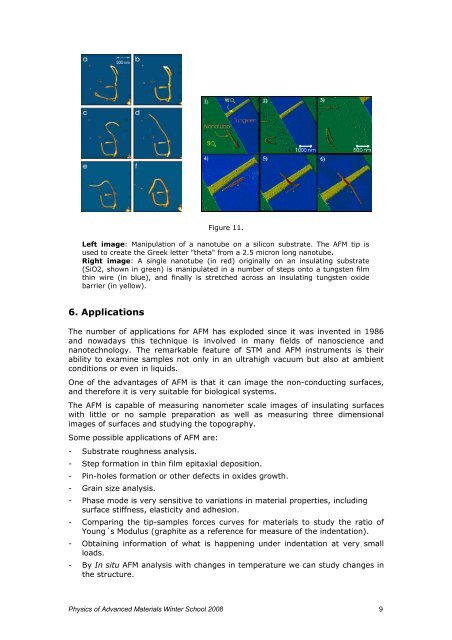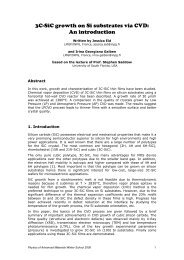Principles of Atomic rinciples Force Microscopy (AFM) - Mansic
Principles of Atomic rinciples Force Microscopy (AFM) - Mansic
Principles of Atomic rinciples Force Microscopy (AFM) - Mansic
Create successful ePaper yourself
Turn your PDF publications into a flip-book with our unique Google optimized e-Paper software.
Figure 11.<br />
Left image: Manipulation <strong>of</strong> a nanotube on a silicon substrate. The <strong>AFM</strong> tip is<br />
used to create the Greek letter "theta" from a 2.5 micron long nanotube.<br />
Right image: A single nanotube (in red) originally on an insulating substrate<br />
(SiO2, shown in green) is manipulated in a number <strong>of</strong> steps onto a tungsten film<br />
thin wire (in blue), and finally is stretched across an insulating tungsten oxide<br />
barrier (in yellow).<br />
6. Applications<br />
The number <strong>of</strong> applications for <strong>AFM</strong> has exploded since it was invented in 1986<br />
and nowadays this technique is involved in many fields <strong>of</strong> nanoscience and<br />
nanotechnology. The remarkable feature <strong>of</strong> STM and <strong>AFM</strong> instruments is their<br />
ability to examine samples not only in an ultrahigh vacuum but also at ambient<br />
conditions or even in liquids.<br />
One <strong>of</strong> the advantages <strong>of</strong> <strong>AFM</strong> is that it can image the non-conducting surfaces,<br />
and therefore it is very suitable for biological systems.<br />
The <strong>AFM</strong> is capable <strong>of</strong> measuring nanometer scale images <strong>of</strong> insulating surfaces<br />
with little or no sample preparation as well as measuring three dimensional<br />
images <strong>of</strong> surfaces and studying the topography.<br />
Some possible applications <strong>of</strong> <strong>AFM</strong> are:<br />
- Substrate roughness analysis.<br />
- Step formation in thin film epitaxial deposition.<br />
- Pin-holes formation or other defects in oxides growth.<br />
- Grain size analysis.<br />
- Phase mode is very sensitive to variations in material properties, including<br />
surface stiffness, elasticity and adhesion.<br />
- Comparing the tip-samples forces curves for materials to study the ratio <strong>of</strong><br />
Young´s Modulus (graphite as a reference for measure <strong>of</strong> the indentation).<br />
- Obtaining information <strong>of</strong> what is happening under indentation at very small<br />
loads.<br />
- By In situ <strong>AFM</strong> analysis with changes in temperature we can study changes in<br />
the structure.<br />
Physics <strong>of</strong> Advanced Materials Winter School 2008 9




